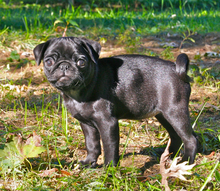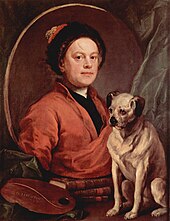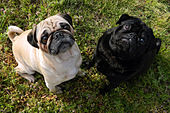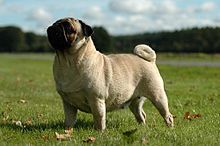Pug: Difference between revisions
| [accepted revision] | [accepted revision] |
m added some info about pugs in the royal family |
Flyingidiot (talk | contribs) →History: Remove extremely inane statement |
||
| Line 48: | Line 48: | ||
[[File:William Hogarth 006.jpg|upright|thumb|alt=A man wearing a red robe and a black hat in a mirror. A small yellow dog with a black nose and ears stands beside the mirror.|[[William Hogarth]] with his pug, Trump, in 1745.]] |
[[File:William Hogarth 006.jpg|upright|thumb|alt=A man wearing a red robe and a black hat in a mirror. A small yellow dog with a black nose and ears stands beside the mirror.|[[William Hogarth]] with his pug, Trump, in 1745.]] |
||
[[File:Louis-Michel van Loo Princess Ekaterina Dmitrievna Golitsyna.jpg|thumb|right|upright|A portrait of Princess Ekaterina Dmitrievna Golitsyna by [[Louis-Michel van Loo]] (1759)<br/>Moscow, [[Pushkin Museum of Fine Arts]]]] |
[[File:Louis-Michel van Loo Princess Ekaterina Dmitrievna Golitsyna.jpg|thumb|right|upright|A portrait of Princess Ekaterina Dmitrievna Golitsyna by [[Louis-Michel van Loo]] (1759)<br/>Moscow, [[Pushkin Museum of Fine Arts]]]] |
||
[[File:Fawn-pug-and-black-pug.jpg|upright|thumb|right|alt=A fawn pug and a black pug looking up.| |
[[File:Fawn-pug-and-black-pug.jpg|upright|thumb|right|alt=A fawn pug and a black pug looking up.|A fawn pug and a black pug.]] |
||
===16th and 17th centuries=== |
===16th and 17th centuries=== |
||
Revision as of 22:47, 17 September 2013
| Pug | |||||||||
|---|---|---|---|---|---|---|---|---|---|
 A fawn pug, the most common coloring. | |||||||||
| Other names | Chinese pug Dutch bulldog Dutch mastiff Mini mastiff Mops Carlin | ||||||||
| Origin | China[1] | ||||||||
| |||||||||
| Dog (domestic dog) | |||||||||
The pug is a toy dog with a wrinkly, short-muzzled face and curled tail. The breed has a fine, glossy coat that comes in a variety of colors, although often black or fawn, and a compact square body with well-developed muscles. Known in ancient China as lo-sze, pugs as breeding animals may have contributed to the English Bulldog, the modern Pekingese and the King Charles Spaniel. Pugs were brought from China to Europe in the seventeenth century and were popularized in Western Europe by the House of Orange of the Netherlands, and the House of Stuart.[2] Pugs remain popular into the twenty-first century, with some famous celebrity owners. A pug was judged Best in Show at the World Dog Show in 2004.
Description
Physical characteristics

While the pugs that are depicted in eighteenth century prints tend to be long and lean,[2] modern breed preferences are for a square cobby body, a compact form, a deep chest, and well-developed muscle.[3] Their smooth and glossy coats can be fawn, apricot fawn, silver fawn, or black.[3] The markings are clearly defined and there is a trace of a black line extending from the occiput to the tail.[3] The tail normally curls tightly over the hip.[2]
Pugs have two distinct shapes for their ears, "rose" and "button". "Rose" ears are smaller than the standard style of "button" ears, and are folded with the front edge against the side of the head. Breeding preference goes to "button" style ears.[4]
Pugs' legs are very strong, straight, of moderate length, and are set well under. Their shoulders are moderately laid back. Their ankles are strong, their feet are small, their toes are well split-up, and their nails are black.[3] The lower teeth normally protrude further than their upper, resulting in an under-bite.[1]
Temperament
The breed is often described as multum in parvo, or "much in little", alluding to the pug's remarkable personality, despite its small size.[1] Pugs are strong willed but rarely aggressive, and are suitable for families with children. The majority of the breed is very fond of children and sturdy enough to properly play with them. Depending on their owner's mood, they can be quiet and docile but also vivacious and teasing.[5]
History


Moscow, Pushkin Museum of Fine Arts

16th and 17th centuries
The pug breed was imported into Europe from China in the 16th century by the Dutch East India Company. It is said to have become the official dog of the House of Orange in 1572 after a pug named Pompey saved the life of the Prince of Orange by alerting him to the approach of assassins.[1] A pug travelled with William III and Mary II when they left the Netherlands to accept the throne of England in 1688.[2] During this period, the pug may have been bred with the old type King Charles spaniel, giving the modern English Toy/King Charles Spaniel its pug characteristics.[6]
The breed eventually became popular in other European countries as well. Pugs were painted by Goya in Spain, and in Italy they rode up front on private carriages, dressed in jackets and pantaloons that matched those of the coachman. They were used by the military to track animals and people, and were also employed as guard dogs.[2]
18th century to present day
The English painter William Hogarth was the devoted owner of a series of pugs. His 1745 self-portrait, which is now in London's Tate Gallery, includes his pug, Trump.[7] The pug was also well known in Italy. In 1789, a Mrs. Piozzi wrote in her journal, "The little pug dog or Dutch mastiff has quitted London for Padua, I perceive. Every carriage I meet here has a pug in it."[8] The popularity of the pug continued to spread in France during the eighteenth century. Before her marriage to Napoleon Bonaparte, Joséphine had her pug Fortune carry concealed messages to her family while she was confined at Les Carmes prison, it having alone been given visiting rights.[9]
In nineteenth century England, the breed flourished under the patronage of Queen Victoria. Her many pugs, which she bred herself, included Olga, Pedro, Minka, Fatima and Venus.[2] Her involvement with dogs in general helped to establish the Kennel Club, which was formed in 1873.[2] Queen Victoria favoured apricot and fawn colors. Queen Victoria's passion for pugs was passed on to many other members of the Royal family, including her grandson King George V[10] and his son King Edward VIII. In paintings and engravings of the 18th and 19th centuries, pugs usually appear with longer legs and noses than today, and with cropped ears. The modern pug's appearance probably changed after 1860 when a new wave of pugs were imported directly from China. These pugs had shorter legs and the modern-style pug nose. The British aristocrat Lady Brassey is credited with making black pugs fashionable after she brought some back from China in 1886.[1][2] Ear cropping was made illegal in 1895.[11]
Pugs arrived in the United States during the nineteenth century and were soon making their way into the family home and the show ring.[2] The American Kennel Club recognized the breed in 1885. The Pug Dog Club of America was founded in 1931 and was recognized by the American Kennel Club that same year. In 1981, the pug Dhandys Favorite Woodchuck won the Westminster Kennel Club Dog Show in the United States, the only pug to have won there since the show began in 1877.[12] The World Champion, or Best in Show at the 2004 World Dog Show held in Rio de Janeiro, Brazil, was a pug named Double D Cinoblu's Masterpiece.[13]
Health problems

Since pugs lack longer snouts and prominent skeletal brow ridges, they are susceptible to eye injuries such as proptosis, scratched corneas, and painful entropion.[2] They also have compact breathing passageways, leaving many prone to breathing difficulties or unable to efficiently regulate their temperature through evaporation from the tongue by panting. A pug's normal body temperature is between 101 °F (38 °C) and 102 °F (39 °C). If this temperature rises to 105 °F (41 °C), oxygen demand is greatly increased and immediate cooling is required. If body temperature reaches 108 °F (42 °C), organ failure can occur.[14]
Pugs that live a mostly sedentary life can be prone to obesity, though this is avoidable with regular exercise and a healthy diet.[15] The median life span of pugs is 11 years, which is in line with other breeds of the same size.[16]
Common conditions

Eye prolapse is a common problem among pugs and other brachycephalic breeds and can be caused by a trauma to the head or neck, or even by the owner using a tight leash instead of a harness.[17] While the eye can usually be pushed back into its socket by the owner or by a vet, veterinary attention is usually advisable. If the prolapse happens on a regular basis, the pug might require surgery, or in a worst case scenario have the eye removed.[18]
An abnormal formation of the hip socket, known as hip dysplasia, affected nearly 64% of pugs in a survey performed by the Orthopedic Foundation for Animals; the breed was ranked the second worst-affected by this condition out of 157 breeds tested.[19]
Pugs, like other short-snouted breeds, have elongated palates. When excited, they are prone to "reverse sneezing" which causes them to quickly (and seemingly laboriously) gasp and snort. The veterinary name for this is pharyngeal gag reflex and it is caused by fluid or debris getting caught under the palate and irritating the throat or limiting breathing. Reverse sneezing episodes are usually not harmful, and massaging the dog's throat or covering its nose in order to make it breathe through its mouth can often shorten a sneezing fit.[20]
Pugs are one of several breeds that are more susceptible than other dogs to demodectic mange, also known as "demodex". This condition is caused when parasitic mites, that are often present in a dog's skin without causing symptoms, are allowed to do damage because their host has a weakened immune system. It is a problem for many young pugs, although not usually a major one, and is easily treatable, but some are especially susceptible and present with a systemic form of the condition.[21] This vulnerability is thought to be genetic and breeders will avoid producing puppies from adults who have this condition.[22] An investigative documentary carried out by the BBC found significant inbreeding between pedigree dogs, with a study by Imperial College, London, showing that the 10,000 pugs in the UK are so inbred that their gene pool is the equivalent of only 50 individuals.[23]
Pugs have many wrinkles in their faces, so owners will often clean inside the creases to avoid irritation and infection.[24]
Serious issues
Pugs can suffer from necrotizing meningoencephalitis (NME), also known as pug dog encephalitis (PDE), an inflammation of the brain and meninges.[25] NME also occurs in other small dogs, such as the Yorkshire Terrier, Maltese, and Chihuahua.[25] There is no known cure for NME, which is believed to be an inherited disease.[26] Dogs usually die or have to be put to sleep within a few months of onset, which, in those susceptible to this condition, is typically between six months and seven years of age.[27]
This breed, along with other brachycephalic dogs (e.g., boxers, bulldogs), are also prone to hemivertebrae.[28] The curled tail of a British bulldog is an example of a hemivertebrae, but when it occurs not in the coccygeal vertebrae but in other areas of the spine, it can cause paralysis. The condition occurs when two parts of a spinal vertebra do not fuse properly while a young pug is still growing, resulting in an irregularly shaped spinal cavity which can put pressure on the spinal cord.[29]
Media and culture
Pugs have been featured in television and film, including Frank the Pug in the film Men in Black, its sequel, and the follow-up animated series. Other films featuring the breed include Hotel for Dogs, The Adventures of Milo and Otis,[30] The Great Race, Disney's Pocahontas and Pocahontas II,[31] Dune,[31] 12 Rounds,[32] and Marie Antoinette.[33] On television, they have appeared in shows such as 101 Dalmatians, The King of Queens, Spin City, Legend of the Dragon, The West Wing, and EastEnders.[34]
Pugs have also appeared in a variety of fictional print media, including the hypnotic Petula in the "Molly Moon" series,[35] Lady Bertram's pug in Mansfield Park[36] and in the book Pugs: God's Little Weirdos, a spin-off from the Sheldon webcomic.[37] They also featured in Nintendogs for the Nintendo DS handheld video game console[38] and a "Perky Pug" pet can be accessed in Blizzard Entertainment's World of Warcraft.[39] Cheeka is a famous pug who appeared in the "You & I" advertising campaign of Vodafone's cellular phone service in India.[40]
Kay Thompson's Eloise, the six-year-old girl who lived in the Plaza Hotel in New York, had a pug named Weenie, whom she described as "a dog that looks like a cat."[41]
Celebrity owners
Celebrity pug owners include financial radio talk show host and best-selling author Dave Ramsey, comedienne Maria Bamford, broadcaster Jonathan Ross, actors Jessica Alba, Hugh Laurie, Gerard Butler,[42] Jenna Elfman,[43] Billy Joel,[44] Kelly Brook and Ted Danson,[45] fashion designer Valentino Garavani, footballer Zlatan Ibrahimović,[46] and musicians Rob Zombie[47] and Frank Iero. From 1952 until the late 1960s, the Duke and Duchess of Windsor often stayed at the Moulin de la Tuilerie, a country retreat outside Paris, where Wallis Simpson "played mummy to her surrogate family of pug dogs".[48] The famous German comedian Vicco von Bülow was a keen spokesman for the breed and featured some of his pugs in comedy sketches, claiming that "A life without pugs is possible but pointless." [49]
Humor
In a 23 May 2007 web issue of The Onion, the breed was lampooned in a satirical news article titled "Dog Breeders Issue Massive Recall of '07 Pugs".[50] The piece satirized pugs and their breeders by writing of the dog and its characteristics as a faulty product, "evidenced" by a fictional quote from the American Pug Breeders Association director: "While pug owners are accustomed to dog malfunction, the latest animals are prone to more problems than just the usual joint failures, overheating, seizures, chronic respiratory defects, and inability to breed without assistance. The latest model pug is simply not in any way a viable dog."[50]
In 2012, the British cartoonist Mark Wood began a series of cartoons about Humphrey the Pug.[51] The series was inspired by his own real-life pug Humphrey, and to illustrate "just how much fun pugs are to have around."[52]
See also
References
- ^ a b c d e "American Kennel Club - Pug History". AKC.org. American Kennel Club. Retrieved 19 August 2006.
- ^ a b c d e f g h i j Farr, Kendall (1999). Pugs in Public. New York: Stewart, Tabori & Chang, a division of U.S. Media Holdings. ISBN 1-55670-939-0.
{{cite book}}: Unknown parameter|coauthors=ignored (|author=suggested) (help) - ^ a b c d "American Kennel Club - Pug". AKC.org. op. cit. Retrieved 14 October 2008.
{{cite web}}: Italic or bold markup not allowed in:|publisher=(help) - ^ "Ears". Pugs.org. Pug Dog Club of America. Retrieved 14 October 2008.
- ^ "Pug Temperament and Personality". PugInformation.org. Retrieved 26 December 2009.
- ^ Moffat, Norma. Cavalier King Charles Spaniel: Your Happy Healthy Pet (2nd ed.). Howell Book House. p. 19. ISBN 0-471-74823-4.
{{cite book}}:|access-date=requires|url=(help); Cite has empty unknown parameter:|coauthors=(help) - ^ William Hogarth. The Painter and his Pug, 1745. Tate Gallery, London, England. www.tate.org.uk. Retrieved 9 April 2013.
- ^ Maggitti, Phil (2000). Pugs: Everything about Purchase, Care, Nutrition, Behavior, and Training. Barron's Educational Series. p. 10. ISBN 978-0-7641-1045-0. Retrieved 17 January 2010.
{{cite book}}: Cite has empty unknown parameter:|coauthors=(help) - ^ Katharine Macdonogh (August). "Prison Pets in the French Revolution". History Today. 46.
{{cite journal}}: Check date values in:|date=(help); Unknown parameter|month=ignored (help) - ^ http://www.royalcollection.org.uk/eGallery/object.asp?searchText=photo&x=0&y=0&object=2107790&row=81
- ^ "Pugs in Art". The Bulldog Information Library. Retrieved 17 January 2010.
- ^ Cunliffe, Juliette. "History of the Pug". DogChannel.com. Retrieved 26 December 2009.
- ^ "Pug Wins World Championship Show". PugNews.com. 20 April 2004. Retrieved 26 December 2009.
- ^ "Keeping your pug cool during the dog days of summer". OwnedByPugs.com. 18 July 2005. Retrieved 26 December 2009.
- ^ "Obesity in Pugs". PugInformation.org. Retrieved 26 December 2009.
- ^ "2004 KC/BSAVA Purebred Dog Health Survey" (PDF). Retrieved 4 August 2010.
- ^ Dogs 101 Pug Video
- ^ Traumatic eye prolapse by Jeff Grognet, D.V.M., B.Sc.(Agr.)
- ^ "Hip Dysplasia Statistics: Hip Dysplasia by Breed". OFFA.org. Ortheopedic Foundation for Animals. Retrieved 14 October 2010.
- ^ Lundgrun, Becky (26 June 2006). "Reverse Sneezing (Pharyngeal Gag Reflex)". VeterinaryPartner.com. Retrieved 26 December 2009.
- ^ "Demodex Mange in Pugs". PugVillage.com. Retrieved 26 December 2009.
- ^ Demodectic Mange in Dogs PetMD Article by T. J. Dunn, Jr., DVM. Retrieved 9 April 2013.
- ^ "Pedigree dogs plagued by disease". BBC News. 19 August 2008. Retrieved 26 December 2009.
- ^ "Pug Health Guide". Pugs.org. op. cit. Retrieved 14 October 2008.
{{cite web}}: Italic or bold markup not allowed in:|publisher=(help) - ^ a b Cynthia M. Kahn, BA, MA, ed. (2010). The Merck Veterinary Manual (10th ed ed.). Kendallville, Indiana: Courier Kendallville, Inc. pp. 1119, 1158. ISBN 0-911910-93-X.
{{cite book}}:|access-date=requires|url=(help);|edition=has extra text (help)CS1 maint: multiple names: editors list (link) - ^ "Slide 1". Pugs.org. op. cit. Retrieved 14 October 2008.
{{cite web}}: Italic or bold markup not allowed in:|publisher=(help) - ^ "Pug Dog Encephalitis". PugPlace.com. Retrieved 26 December 2009.
- ^ "Hemivertebrae". barkbytes.com. Retrieved 14 October 2008.
- ^ "Pug Health Management". MyDogBreed.com. Retrieved 26 December 2009.
- ^ "The Adventures of Milo and Otis". MoviePooper.com. Retrieved 16 December 2009.
- ^ a b "Pug Power: Pugs In Cinema". MutantReviewers.com. Retrieved 26 December 2009.
- ^ "Critic Reviews: 12 Rounds". Fandango.com. Retrieved 26 December 2009.
- ^ "Trivia for Marie Antoinette (2006)". IMDB. Retrieved 19 September 2010.
- ^ "Pug Information". SarahsDogs.com. Retrieved 26 December 2009.
- ^ Shannon, Terry Miller. "Review: Molly Moon's Hypnotic Time Travel Adventure". KidsReads.com. Retrieved 26 December 2009.
- ^ "Lady Bertram's Lapdog: In the Empire Rests in Mansfield Park". Oxford, UK: Oxford U. Pr. 2005 work=OxfordJournals.org. Retrieved 26 December 2009.
{{cite web}}: Check date values in:|year=(help); Missing pipe in:|year=(help)CS1 maint: year (link) - ^ Kellet, Dave (9 July 2008). "Announcement: The Next Book!". SheldonComics.com. Retrieved 26 December 2009.
- ^ "IGN UK Nintendogs: Dachshund & Friends Review". IGN UK Edition. 22 August 2005. Retrieved 26 December 2009.
- ^ Fernandez, Angelo (4 November 2009). "MMO Champion Brings us Perky Pug Preview". EveryJoe.com. Retrieved 26 December 2009.
- ^ Vodafone brings pug back to promote its 'superior' network The Economic Times. February 2012. Retrieved 9 April 2013.
- ^ Kay Thompson's Eloise: A Book for Precocious Grown Ups (Simon & Schuster 1955), p. 22.
- ^ "New York Man Accuses Gerard Butler of Hitting His Dog". People. Los Angeles, CA, US: Time, Inc. 26 August 2009. Retrieved 26 December 2009.
- ^ "Jenna Elfman". HSUS.org. The Humane Society of the United States. Retrieved 26 December 2009.[dead link]
- ^ "Billy Joel Interviewed By The New York Times Magazine | The Official Billy Joel Site". Billyjoel.com. 26 May 2013. Retrieved 16 June 2013.
- ^ "'Lucky Pug Blog - Celebrities with Pugs".
- ^ "History of Zlatan Ibrahimovic". Zlatan.me. Retrieved 26 December 2009.
- ^ "Zombie's Pug Keeps Pals in Check". ContactMusic.com. 28 August 2006. Retrieved 26 December 2009.
- ^ In Wallis's footsteps: The holiday home by royal appointment The Independent, 25 March 2010. Retrieved 9 April 2013.
- ^ "Ein Leben ohne Mops ist möglich aber sinnlos" (PDF).
- ^ a b "Dog Breeders Issue Massive Recall Of '07 Pugs". The Onion. 23 May 2007. Retrieved 14 October 2008. Issue 43•21.
- ^ Mark Wood: Humphrey... the comic strip about the lovable little pug. Mark Wood Cartoonist Retrieved 7 March 2013.
- ^ Mark Wood: About Humphrey "The inspiration behind the Humphrey comic strip is my wonderful pug, surprise, surprise called Humphrey... a constant source of joy, happiness and laughter." Retrieved 7 March 2013.
